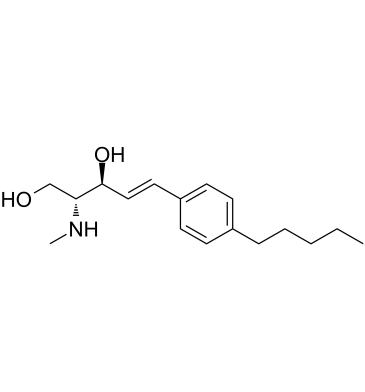SK1-I (Synonyms: BML-258) |
| Catalog No.GC61597 |
SK1-I (BML-258), an analog of sphingosine, is an isozyme-specific competitive SPHK1 inhibitor with a Ki value of 10 ?M. SK1-I shows no activity at SPHK1 PKCα, PKCδ, PKA, AKT1, ERK1, EGFR, CDK2, IKKβ or CamK2β. SK1-I enhances autophagy and has antitumor activity.
Products are for research use only. Not for human use. We do not sell to patients.

Cas No.: 1072443-89-0
Sample solution is provided at 25 µL, 10mM.
SK1-I (BML-258), an analog of sphingosine, is an isozyme-specific competitive SPHK1 inhibitor with a Ki value of 10 µM[1]. SK1-I shows no activity at SPHK1 PKCα, PKCδ, PKA, AKT1, ERK1, EGFR, CDK2, IKKβ or CamK2β. SK1-I enhances autophagy and has antitumor activity[2].
SK1-I (0-10 μM; 24 hours) attenuates cancer cell growth and survival in a TP53-dependent manner in HCT116 cells and HCT116 cells bearing TP53 null cancer[2].SK1-I (0-20 μM; 12 hours) induces more CASP3 cleavage in HCT116 cells, compared to HCT116 cells lacking TP53, leading to a hallmark of apoptosis[2]. Cell Viability Assay[2] Cell Line: HCT116 cells and HCT116 cells bearing TP53 null cancer
Pre-treatment with SK1-I (BML-258; intraperitoneal (i.p.) injection; once; 24 hours prior to baseline mean arterial blood pressure (MAP) measurement; 75 mg/kg) before anandamide (i.v. injection; two doses; 1 and 10 mg/kg) significantly decreases the hypotensive response[3]. Animal Model: Male C57BL/6 mice (24?±?3.5?g) [3]
[1]. Melissa R Pitman, et al. Inhibitors of the sphingosine kinase pathway as potential therapeutics. Curr Cancer Drug Targets. 2010 Jun;10(4):354-67. [2]. Santiago Lima, et al. TP53 is required for BECN1- and ATG5-dependent cell death induced by sphingosine kinase 1 inhibition. Autophagy. 2018;14(6):942-957. [3]. Fiona H Greig, et al. Requirement for sphingosine kinase 1 in mediating phase 1 of the hypotensive response to anandamide in the anaesthetised mouse. Eur J Pharmacol. 2019 Jan 5;842:1-9.
Average Rating: 5 (Based on Reviews and 30 reference(s) in Google Scholar.)
GLPBIO products are for RESEARCH USE ONLY. Please make sure your review or question is research based.
Required fields are marked with *




















